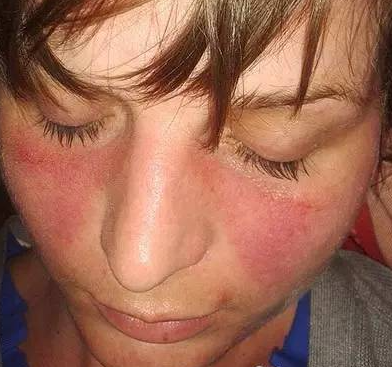
You notice it in the mirror one morning—a redness across your cheeks and the bridge of your nose, forming a distinct shape that reminds you of a butterfly with its wings unfurled. At first, you might dismiss it as a sunburn, a flush of embarrassment, or a strange allergic reaction. But when it persists, refusing to fade with time or topical creams, a quiet concern begins to grow. This is no ordinary rash.
This distinctive “butterfly rash,” known medically as a malar rash, is one of the body’s most dramatic and specific warning signs. It is often the first visible herald of a much deeper, systemic issue: Lupus, or more specifically, Systemic Lupus Erythematosus (SLE).
While a butterfly rash does not automatically mean you have lupus, in the vast landscape of autoimmune diseases, it is one of the most recognized calling cards. Its appearance is a signal that the body’s internal defense system has become profoundly confused.
The Body’s Civil War
Under normal circumstances, your immune system is a loyal army, defending you against foreign invaders like bacteria and viruses. Lupus is what happens when that army turns its weapons on its own homeland—your healthy tissues and organs. It is a state of civil war within the body.
The butterfly rash is a visible battlefield on the skin. It occurs because the immune system is creating inflammation and autoantibodies that attack the skin cells and the small blood vessels beneath, causing the characteristic redness and irritation. The reason it often appears or worsens after sun exposure is that ultraviolet light can further trigger this misguided immune response.
More Than Skin Deep: The Systemic Storm
The critical thing to understand about the butterfly rash is that it is rarely just a skin problem. It is the tip of the iceberg, a visible clue to a storm raging throughout the entire body. The same inflammatory process affecting your face can be silently attacking other vital systems.
This is why a doctor, upon seeing this rash, will look for other signs of the systemic “civil war,” which can include:
- Overwhelming Fatigue: A deep, unshakable exhaustion that rest doesn’t cure.
- Joint Pain and Swelling: Mimicking arthritis, often in the hands, wrists, and knees.
- Fever: Low-grade fevers without any sign of infection.
- Hair Loss: Clumps of hair may fall out, not just from the scalp but sometimes the eyebrows and eyelashes.
- Chest Pain: When the inflammation attacks the lining of the heart or lungs (pleurisy or pericarditis).
- Kidney Problems: Often silent at first, but a primary target for lupus, detectable only through urine and blood tests.
What to Do If You See the Wings
- Don’t Panic, But Do Pay Attention. Not everyone with a butterfly rash has lupus. It can sometimes be associated with other conditions like rosacea. The key is its persistence and its association with other symptoms.
- See Your Doctor, and Consider a Rheumatologist. Your primary care physician is the first stop. Describe all your symptoms, not just the rash. Be prepared to be referred to a rheumatologist, a doctor who specializes in autoimmune and inflammatory diseases.
- Prepare for a Detective Hunt. There is no single test for lupus. Diagnosis is like putting together a puzzle. Your doctor will take a detailed history, perform a physical exam, and order blood tests looking for specific markers like:
- Antinuclear Antibody (ANA): A positive test is a common screening tool, though not definitive for lupus.
- Other Antibodies: Tests for anti-dsDNA and anti-Smith antibodies, which are more specific for lupus.
- Complement Levels: Measuring proteins in the blood that are often low during lupus flares.
- Urine Analysis: To check for early signs of kidney involvement.
A butterfly-shaped rash across the face is a plea for awareness. It is your body’s way of making an invisible, internal war visible. By heeding this signal and seeking a thorough medical evaluation, you are taking a powerful step toward putting a name to the struggle, beginning treatment to manage the inflammation, and protecting your vital organs from further harm. It is the first, crucial move in learning to live with, and triumph over, a complex condition.